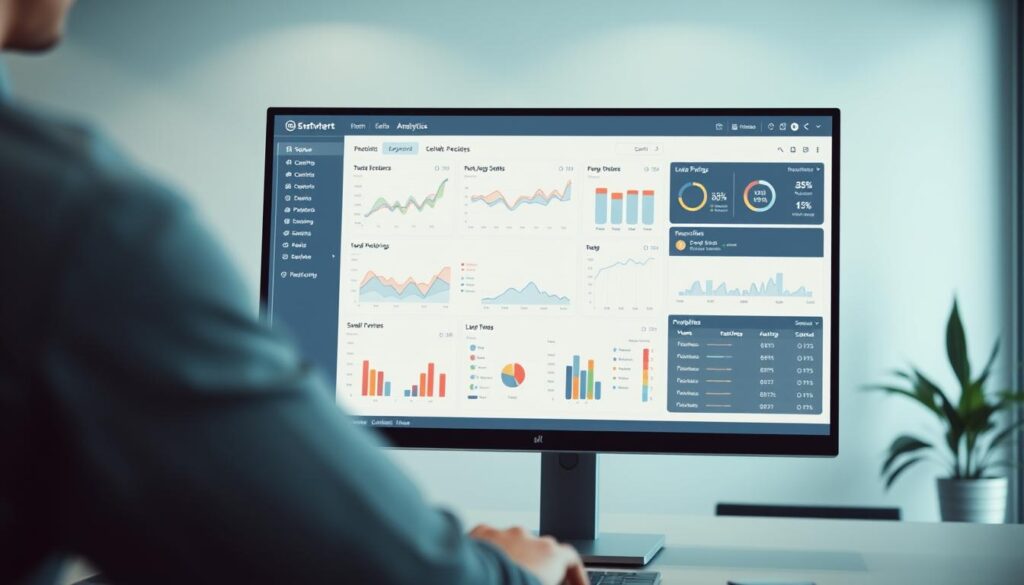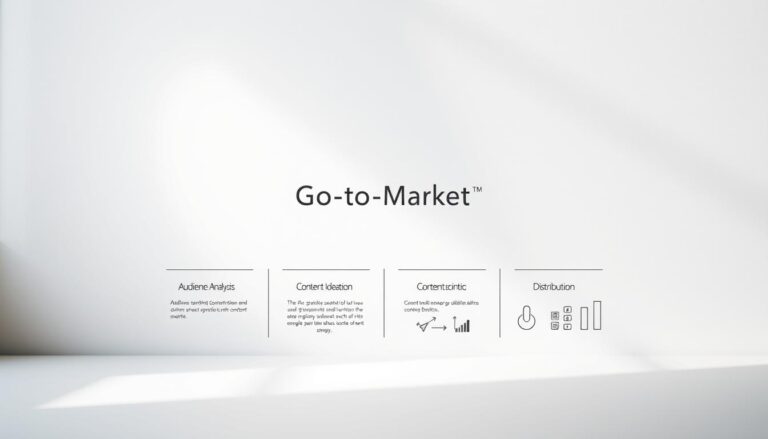The rise of AI-powered sales forecasting tools has revolutionized how sales predictions are made. These AI sales prediction software help businesses make smarter decisions leading to revenue growth. In the past, companies struggled with inaccurate forecasts, causing poor resource use and slow growth.
Thanks to the latest technology, firms can now improve their forecast accuracy. This change turns uncertain revenue into predictable success. So, using automated sales forecasting tools is becoming a must for staying ahead in today’s market.
Key Takeaways
- AI-powered sales forecasting tools significantly enhance accuracy in sales predictions.
- Reliable forecasts help in optimal resource allocation and business strategies.
- Automated tools streamline the forecasting process, saving time and resources.
- Advanced technologies are crucial for turning unpredictable revenues into stable growth.
- Staying competitive increasingly necessitates the use of AI in sales forecasting.
Understanding AI-Powered Sales Forecasting Tools
AI-powered sales forecasting tools are changing the game in predicting sales. They use smart algorithms and lots of data. They mix past trends and current facts to make precise forecasts. Nowadays, businesses are moving towards these AI tools for better sales forecasting.
Definition and Purpose
These tools aim to give companies accurate sales forecasts. They use predictive analytics to spot customer behavior patterns and predict future demand. This reduces guessing and manual work, making sales strategies more effective.
Evolution of Sales Forecasting
Sales forecasting has changed a lot. In the past, it depended mostly on past sales and the sales team’s opinions. Now, using AI, companies benefit from machine learning and data insights. This shifts the focus to more accurate and adaptable forecasting models.
Key Technologies Behind AI
A few technologies are key to the power of AI sales forecasting tools. Some of these are:
- Predictive analytics: Analyses past data to find trends.
- Machine learning algorithms: They get smarter with new data for better forecasts.
- Automation tools: They make collecting and reporting data easier and more efficient.
These advanced technologies help businesses make decisions based on strong predictions. This leads to better sales and growth.
| Key Technology | Function | Impact on Forecasting |
|---|---|---|
| Predictive Analytics | Analyzes historical and current data | Identifies trends and patterns for informed predictions |
| Machine Learning | Adapts to new information continuously | Improves prediction accuracy over time |
| Automation Tools | Streamlines data collection | Saves time and resources, enhances productivity |
Benefits of Implementing AI in Sales Forecasting
Using AI in sales forecasting brings big benefits. It helps businesses make better plans by predicting sales more accurately. This means companies can trust their strategies more.
AI tools for sales forecasting turn a lot of data into useful information. This helps in making smart choices.
Improved Accuracy and Reliability
AI is great at analyzing a lot of data without needing much help from people. This cuts down mistakes often seen in older methods. Companies get not just better but also reliable forecasts. This lets them make choices with more confidence.
Enhanced Decision-Making Capabilities
Tools that predict sales with machine learning give sales teams insights based on current data. Having the latest information lets companies quickly adapt to changes in the market. They can grab new chances and tweak plans when needed.
Time and Resource Efficiency
Using AI to predict sales saves a lot of time that used to go into analyzing data by hand. Sales teams can then spend more time on more important work. This change means using resources better and improving how things run.
| Benefit | Description | Example |
|---|---|---|
| Accuracy | Reduction of human error in forecasts | AI predicts sales with 95% accuracy |
| Decision-Making | Enables timely reactions to market changes | Quick adjustment based on new customer trends |
| Resource Efficiency | Reduction of time spent in manual processes | Sales cycle shortened by 30% |

How AI-Powered Tools Create Forecasts
Automated sales tools use smart processes for accurate sales forecasts. First, they gather and analyze data. This step is key for making trustworthy forecasts. Combining various data like Customer Relationship Management (CRM) and Enterprise Resource Planning (ERP) systems is crucial. It helps create a full picture for insightful actions.
Data Collection and Analysis
First, these tools collect sales data, market trends, and customer behaviors. This ensures the data is broad and useful. Automated tools quickly gather data and keep it up-to-date. They turn raw data into organized formats for deeper analysis and understanding.
Machine Learning Algorithms in Action
Machine learning algorithms then analyze the historical data to find patterns. Unlike old methods, machine learning improves as it gets more data. This lets businesses instantly adjust to market changes.
Predictive Analytics Explained
Predictive analytics is key for forecasting sales. It uses complex algorithms to make forecasts from past data trends. The mix of data and predictive analytics starts artificial intelligence in sales forecasting. This combo makes forecasting more accurate, helping companies plan better for future sales.
| Stage | Process | Outcome |
|---|---|---|
| Data Collection | Integrating data from CRM and ERP systems | Comprehensive datasets for analysis |
| Data Analysis | Transformation of raw data into structured formats | Actionable insights and trends |
| Machine Learning | Application of algorithms to uncover patterns | Dynamic predictions and real-time adjustments |
| Predictive Analytics | Utilization of trends for forecast generation | Improved forecast accuracy |
Popular AI-Powered Sales Forecasting Tools in the Market
The world of AI-powered sales forecasting tools has grown a lot. Now, companies have many options to pick from to get better at predicting sales. We’ll look at the key tools out there, compare their features, and see what users think about how well they work in real life.
Overview of Leading Solutions
Big names like Salesforce, HubSpot, and Clari lead the pack in sales forecasting AI tools. Each one offers special features designed for different types of businesses.
Comparative Features and Pricing
The cost of automated sales forecasting tools isn’t the same across the board. Here’s a table that shows how some of the top tools stack up against each other:
| Tool | Key Features | Pricing Range |
|---|---|---|
| Salesforce | Advanced analytics, CRM integration | $25 – $300/month |
| HubSpot | User-friendly interface, reporting tools | Free to $800/month |
| Clari | Real-time visibility, AI insights | $75 – $150/month |
| Forecastio | Simple UI, versatile forecasting | $50 – $200/month |
| Weflow | Collaboration features, data integration | $30 – $100/month |
User Feedback and Case Studies
Companies that use AI for sales forecasting have seen big improvements. They report more accurate predictions which help in planning better strategies. Stories from these businesses show that using these tools can really boost sales outcomes.
Challenges and Limitations of AI Sales Forecasting
Using AI for sales predictions can make forecasts more accurate and efficient. Yet, there are challenges to overcome for full benefits. Each issue needs careful thought and a strategy.
Data Quality and Integration Issues
Data is key for effective AI sales forecasts. Poor data can lead to wrong business decisions. Adding different sources of data can make things complex. Without good data management, AI forecasts won’t be reliable.
Resistance to Change in Organizations
Introducing AI can face pushback within companies. Workers might worry about changes to their routines and doubt AI’s reliability. Creating an environment that welcomes new ideas is crucial. It helps in using AI tools well.
Understanding AI Limitations
AI tools improve analysis but can’t think like humans. Knowing AI’s limits is part of the challenge. The best forecasts mix AI with human insight.
Best Practices for Maximizing AI Sales Forecasting Tools
To make the most of AI sales forecasting tools, companies need to follow key steps. These steps help make sure sales predictions are right on point and useful. They also need to fit well with how fast things change in business. Here are important methods to boost your success with advanced sales forecasting.
Training and Onboarding Teams
It’s crucial to teach sales teams well. This training must show them how to work with AI for predicting sales. Knowing how to use these tools helps them make smart decisions and work better together.
Regularly Updating Data Inputs
Keeping data fresh is key for accurate predictions. Without it, you might get wrong forecasts. Companies should regularly check and refresh their data to keep forecasts sharp.
Monitoring and Adjusting Forecast Models
It’s important to keep an eye on how well forecast models are doing. This helps you stay in tune with the market. By being ready to tweak models, teams can quickly adapt to new trends.

The Future of AI in Sales Forecasting
Sales forecasting is changing fast because of new technologies. Looking ahead, we see machine learning and closer ties with customer systems making big improvements. The move to predictive analytics for sales will help companies make smarter choices. They’ll manage market challenges better too.
Emerging Trends and Technologies
One big step forward is AI that updates its predictions as new data comes in. This means not only better forecasts but also quicker strategy changes according to market shifts. Using such tech helps companies spot opportunities and avoid risks on time.
The Role of AI in Sales Strategy Development
AI does more than just predict sales; it’s key in making sales plans. Companies using AI make choices based on solid data, boosting their strategies. This data helps sales teams understand customer needs, improve how they interact, and match their actions to what customers want. This leads to stronger sales and better use of resources.
Predictions for the Next Decade
In the future, AI in sales will give companies a competitive advantage. Those using AI well will likely beat their rivals, showing how important predictive analytics is for creating new solutions and improving customer service. As AI grows smarter, we’ll see more automated forecasting systems. These will change the way companies succeed in sales over the next ten years.
FAQ
What are AI-powered sales forecasting tools?
AI-powered sales forecasting tools use artificial intelligence to analyze past data. They predict how well sales will do in the future. This makes sales forecasts more accurate.
How do AI sales prediction software enhance forecasting accuracy?
These tools look at tons of data from CRM systems and ERP platforms. They use this data to make smarter predictions. This reduces mistakes often made by humans.
What role does predictive analytics play in sales forecasting?
Predictive analytics helps businesses understand customer buying patterns. This leads to better sales forecasts. It also guides strategic decisions by spotting trends.
Can you provide examples of popular AI-powered sales forecasting tools?
Some top tools are Salesforce, HubSpot, Clari, Forecastio, and Weflow. Each one has different features and prices to fit various businesses.
What challenges might organizations face when implementing AI in sales forecasting?
Challenges include data quality and integration issues, resistance to new technology, and the limits of AI. AI can’t fully take over human decision-making.
What are best practices for using AI-powered sales forecasting tools effectively?
Best practices include training sales teams well, keeping data up to date, and regularly adjusting forecasts. It’s important to act on the latest sales data.
How does machine learning contribute to sales forecasting?
Machine learning looks at past data to find patterns we might miss. This helps make future sales predictions more trustworthy.
What is the expected future of AI in sales forecasting?
The future will see better machine learning, better integration with customer systems, and more use of data insights. Companies using AI will likely get ahead.



